Essay on Corporate Entrepreneurship and Innovation Strategies
VerifiedAdded on 2020/04/13
|12
|3496
|215
Essay
AI Summary
This essay delves into the realm of corporate entrepreneurship and innovation, examining the crucial role of creative thinking and the challenges businesses face in sustaining innovation. It explores the concept of corporate entrepreneurship, highlighting the importance of innovation as a core element for long-term success. The essay identifies key barriers, such as the clash between old and new business cultures, traditional management strategies, and outdated technologies, using real-world examples like RR Donnelley and Enron to illustrate these points. It also provides strategies for overcoming these barriers, emphasizing the need for open communication, disciplined planning, and a balanced approach to operations, strategies, and organization. The essay advocates for a culture that embraces experimentation, customer-focused approaches, and non-financial performance metrics to foster sustained innovation. It concludes by suggesting that companies must continuously adapt and evolve to remain competitive in an ever-changing business environment.
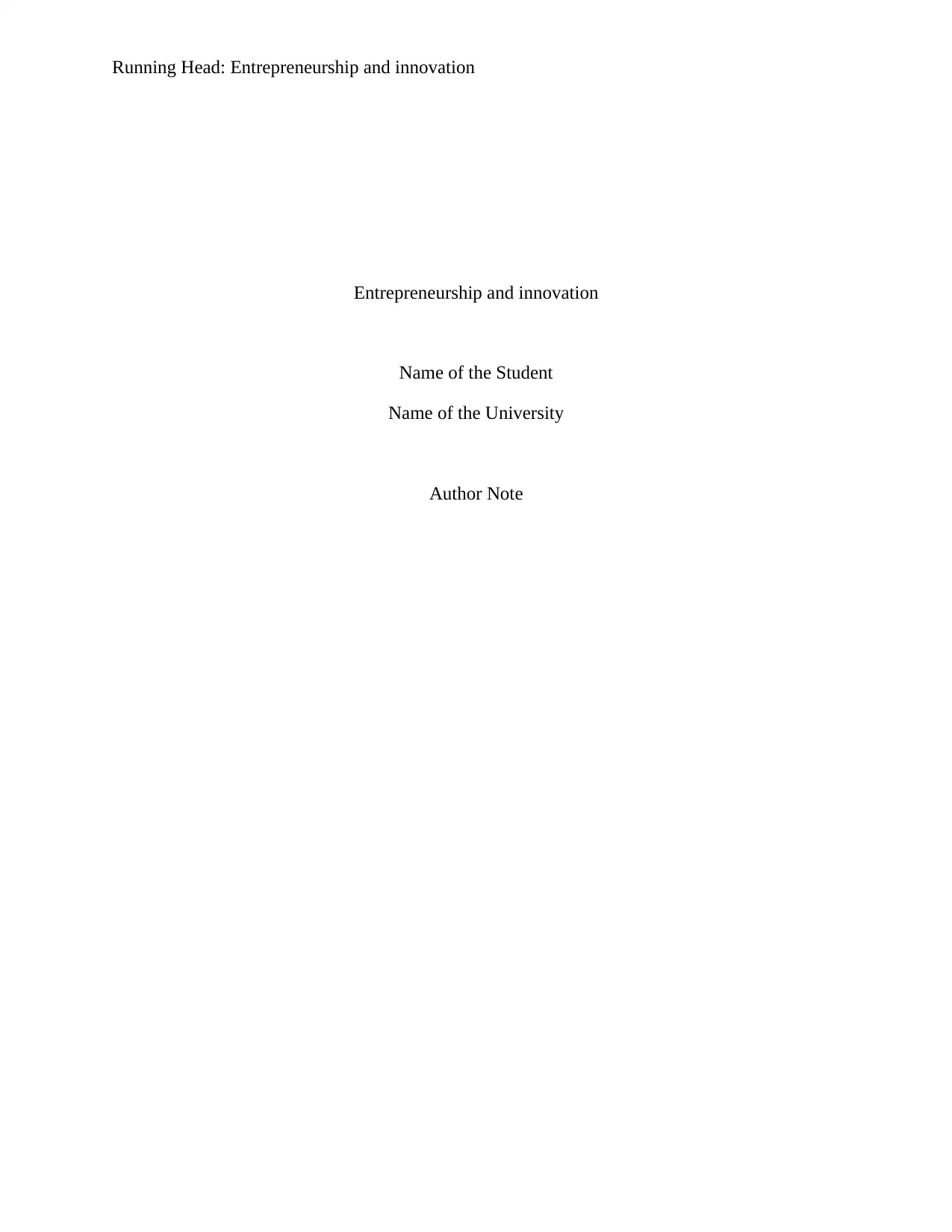
Running Head: Entrepreneurship and innovation
Entrepreneurship and innovation
Name of the Student
Name of the University
Author Note
Entrepreneurship and innovation
Name of the Student
Name of the University
Author Note
Paraphrase This Document
Need a fresh take? Get an instant paraphrase of this document with our AI Paraphraser
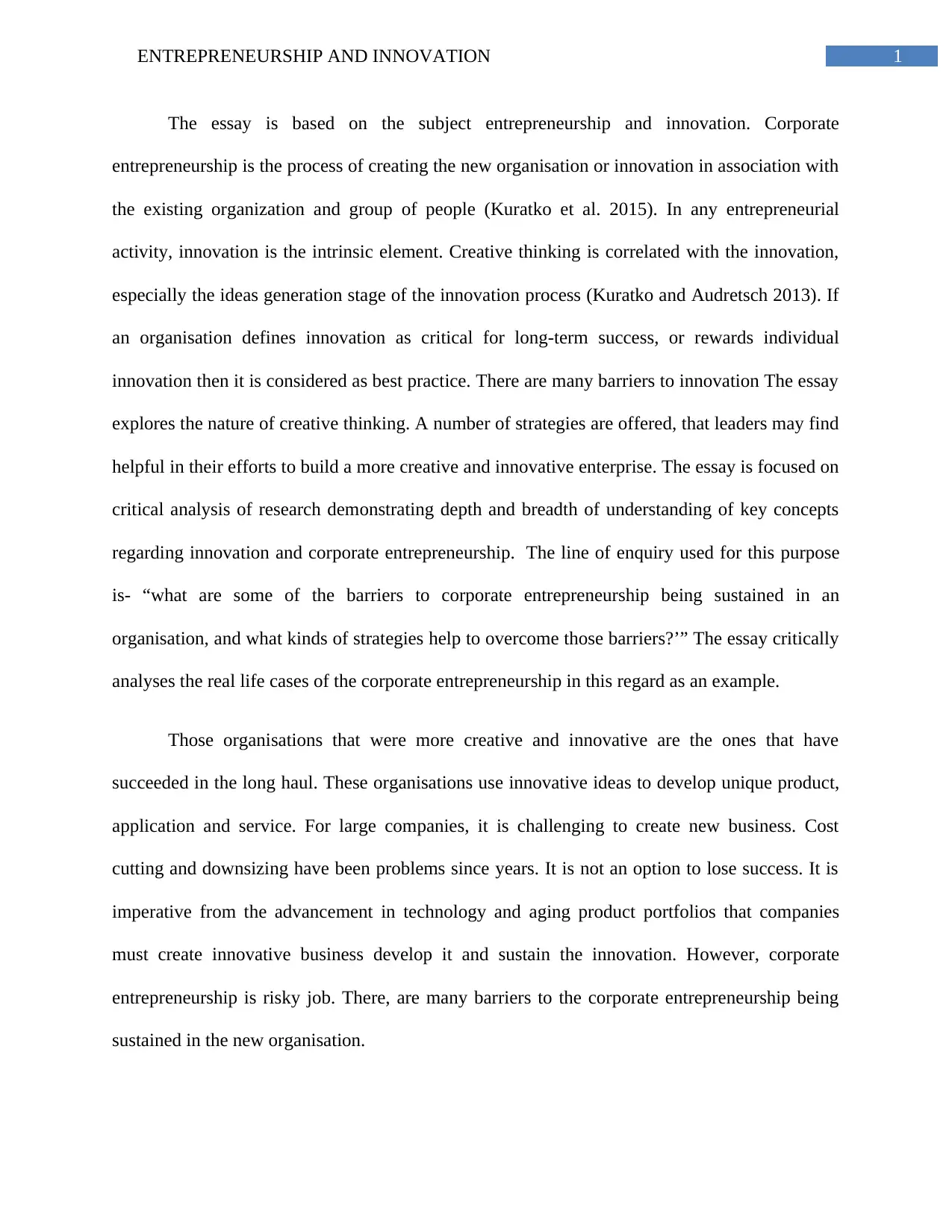
1ENTREPRENEURSHIP AND INNOVATION
The essay is based on the subject entrepreneurship and innovation. Corporate
entrepreneurship is the process of creating the new organisation or innovation in association with
the existing organization and group of people (Kuratko et al. 2015). In any entrepreneurial
activity, innovation is the intrinsic element. Creative thinking is correlated with the innovation,
especially the ideas generation stage of the innovation process (Kuratko and Audretsch 2013). If
an organisation defines innovation as critical for long-term success, or rewards individual
innovation then it is considered as best practice. There are many barriers to innovation The essay
explores the nature of creative thinking. A number of strategies are offered, that leaders may find
helpful in their efforts to build a more creative and innovative enterprise. The essay is focused on
critical analysis of research demonstrating depth and breadth of understanding of key concepts
regarding innovation and corporate entrepreneurship. The line of enquiry used for this purpose
is- “what are some of the barriers to corporate entrepreneurship being sustained in an
organisation, and what kinds of strategies help to overcome those barriers?’” The essay critically
analyses the real life cases of the corporate entrepreneurship in this regard as an example.
Those organisations that were more creative and innovative are the ones that have
succeeded in the long haul. These organisations use innovative ideas to develop unique product,
application and service. For large companies, it is challenging to create new business. Cost
cutting and downsizing have been problems since years. It is not an option to lose success. It is
imperative from the advancement in technology and aging product portfolios that companies
must create innovative business develop it and sustain the innovation. However, corporate
entrepreneurship is risky job. There, are many barriers to the corporate entrepreneurship being
sustained in the new organisation.
The essay is based on the subject entrepreneurship and innovation. Corporate
entrepreneurship is the process of creating the new organisation or innovation in association with
the existing organization and group of people (Kuratko et al. 2015). In any entrepreneurial
activity, innovation is the intrinsic element. Creative thinking is correlated with the innovation,
especially the ideas generation stage of the innovation process (Kuratko and Audretsch 2013). If
an organisation defines innovation as critical for long-term success, or rewards individual
innovation then it is considered as best practice. There are many barriers to innovation The essay
explores the nature of creative thinking. A number of strategies are offered, that leaders may find
helpful in their efforts to build a more creative and innovative enterprise. The essay is focused on
critical analysis of research demonstrating depth and breadth of understanding of key concepts
regarding innovation and corporate entrepreneurship. The line of enquiry used for this purpose
is- “what are some of the barriers to corporate entrepreneurship being sustained in an
organisation, and what kinds of strategies help to overcome those barriers?’” The essay critically
analyses the real life cases of the corporate entrepreneurship in this regard as an example.
Those organisations that were more creative and innovative are the ones that have
succeeded in the long haul. These organisations use innovative ideas to develop unique product,
application and service. For large companies, it is challenging to create new business. Cost
cutting and downsizing have been problems since years. It is not an option to lose success. It is
imperative from the advancement in technology and aging product portfolios that companies
must create innovative business develop it and sustain the innovation. However, corporate
entrepreneurship is risky job. There, are many barriers to the corporate entrepreneurship being
sustained in the new organisation.
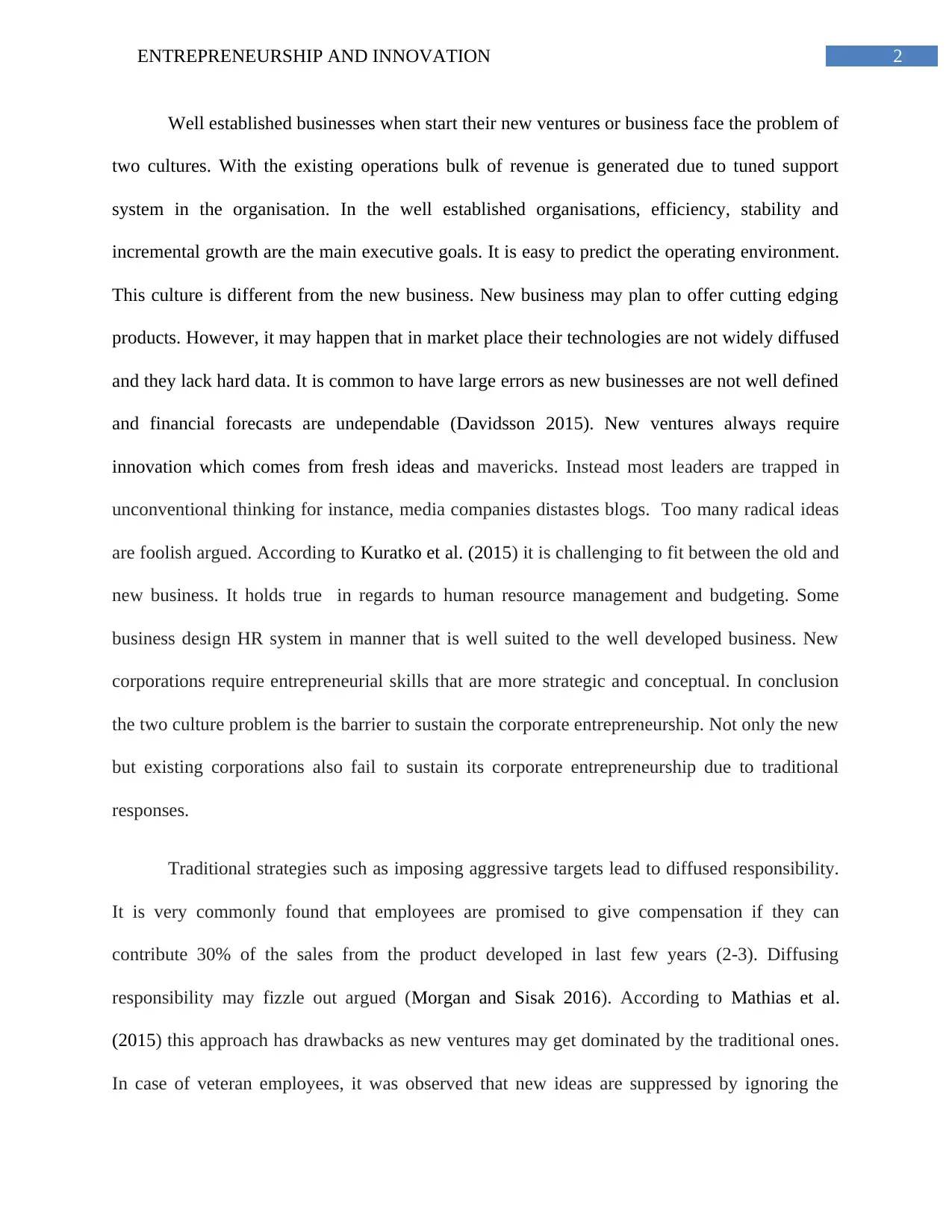
2ENTREPRENEURSHIP AND INNOVATION
Well established businesses when start their new ventures or business face the problem of
two cultures. With the existing operations bulk of revenue is generated due to tuned support
system in the organisation. In the well established organisations, efficiency, stability and
incremental growth are the main executive goals. It is easy to predict the operating environment.
This culture is different from the new business. New business may plan to offer cutting edging
products. However, it may happen that in market place their technologies are not widely diffused
and they lack hard data. It is common to have large errors as new businesses are not well defined
and financial forecasts are undependable (Davidsson 2015). New ventures always require
innovation which comes from fresh ideas and mavericks. Instead most leaders are trapped in
unconventional thinking for instance, media companies distastes blogs. Too many radical ideas
are foolish argued. According to Kuratko et al. (2015) it is challenging to fit between the old and
new business. It holds true in regards to human resource management and budgeting. Some
business design HR system in manner that is well suited to the well developed business. New
corporations require entrepreneurial skills that are more strategic and conceptual. In conclusion
the two culture problem is the barrier to sustain the corporate entrepreneurship. Not only the new
but existing corporations also fail to sustain its corporate entrepreneurship due to traditional
responses.
Traditional strategies such as imposing aggressive targets lead to diffused responsibility.
It is very commonly found that employees are promised to give compensation if they can
contribute 30% of the sales from the product developed in last few years (2-3). Diffusing
responsibility may fizzle out argued (Morgan and Sisak 2016). According to Mathias et al.
(2015) this approach has drawbacks as new ventures may get dominated by the traditional ones.
In case of veteran employees, it was observed that new ideas are suppressed by ignoring the
Well established businesses when start their new ventures or business face the problem of
two cultures. With the existing operations bulk of revenue is generated due to tuned support
system in the organisation. In the well established organisations, efficiency, stability and
incremental growth are the main executive goals. It is easy to predict the operating environment.
This culture is different from the new business. New business may plan to offer cutting edging
products. However, it may happen that in market place their technologies are not widely diffused
and they lack hard data. It is common to have large errors as new businesses are not well defined
and financial forecasts are undependable (Davidsson 2015). New ventures always require
innovation which comes from fresh ideas and mavericks. Instead most leaders are trapped in
unconventional thinking for instance, media companies distastes blogs. Too many radical ideas
are foolish argued. According to Kuratko et al. (2015) it is challenging to fit between the old and
new business. It holds true in regards to human resource management and budgeting. Some
business design HR system in manner that is well suited to the well developed business. New
corporations require entrepreneurial skills that are more strategic and conceptual. In conclusion
the two culture problem is the barrier to sustain the corporate entrepreneurship. Not only the new
but existing corporations also fail to sustain its corporate entrepreneurship due to traditional
responses.
Traditional strategies such as imposing aggressive targets lead to diffused responsibility.
It is very commonly found that employees are promised to give compensation if they can
contribute 30% of the sales from the product developed in last few years (2-3). Diffusing
responsibility may fizzle out argued (Morgan and Sisak 2016). According to Mathias et al.
(2015) this approach has drawbacks as new ventures may get dominated by the traditional ones.
In case of veteran employees, it was observed that new ideas are suppressed by ignoring the
⊘ This is a preview!⊘
Do you want full access?
Subscribe today to unlock all pages.

Trusted by 1+ million students worldwide
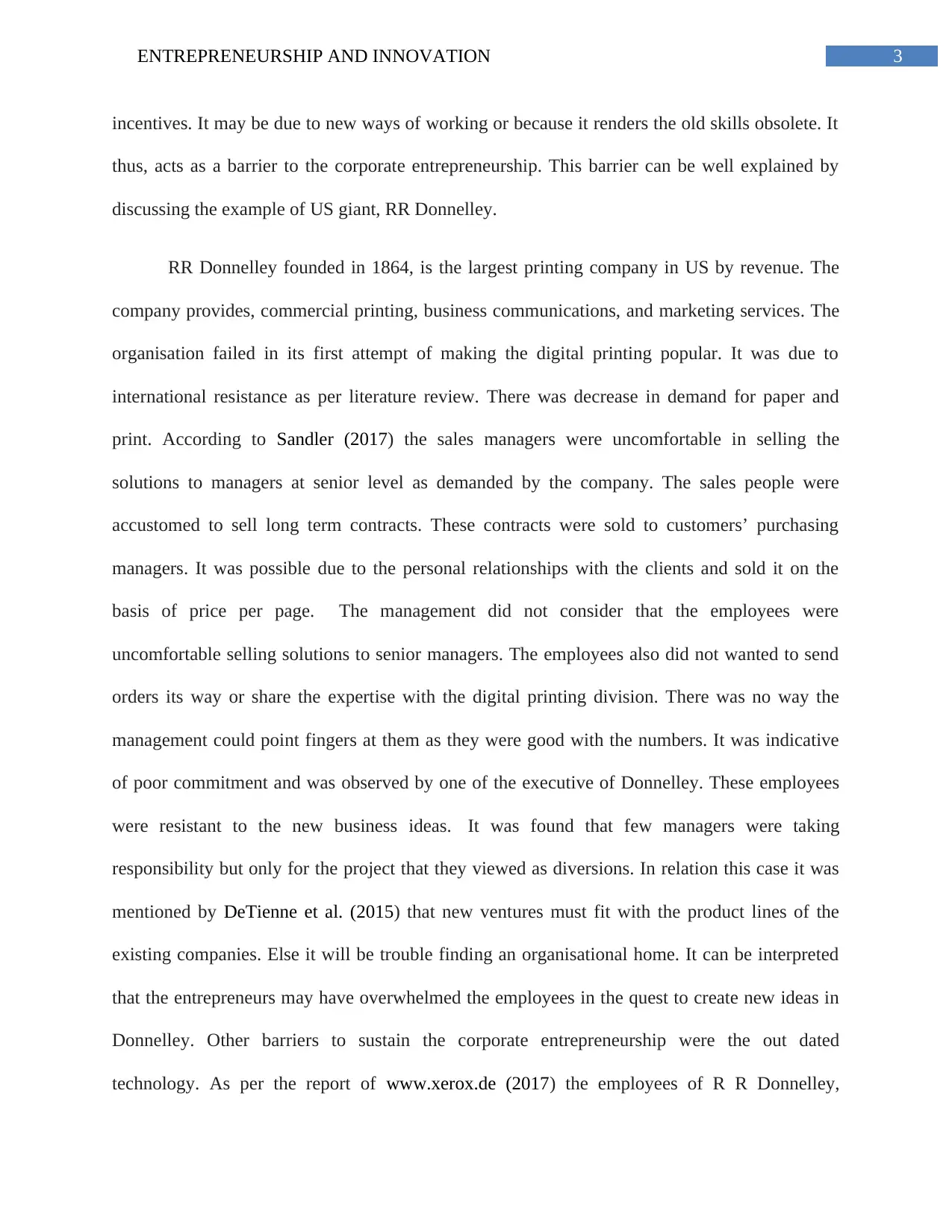
3ENTREPRENEURSHIP AND INNOVATION
incentives. It may be due to new ways of working or because it renders the old skills obsolete. It
thus, acts as a barrier to the corporate entrepreneurship. This barrier can be well explained by
discussing the example of US giant, RR Donnelley.
RR Donnelley founded in 1864, is the largest printing company in US by revenue. The
company provides, commercial printing, business communications, and marketing services. The
organisation failed in its first attempt of making the digital printing popular. It was due to
international resistance as per literature review. There was decrease in demand for paper and
print. According to Sandler (2017) the sales managers were uncomfortable in selling the
solutions to managers at senior level as demanded by the company. The sales people were
accustomed to sell long term contracts. These contracts were sold to customers’ purchasing
managers. It was possible due to the personal relationships with the clients and sold it on the
basis of price per page. The management did not consider that the employees were
uncomfortable selling solutions to senior managers. The employees also did not wanted to send
orders its way or share the expertise with the digital printing division. There was no way the
management could point fingers at them as they were good with the numbers. It was indicative
of poor commitment and was observed by one of the executive of Donnelley. These employees
were resistant to the new business ideas. It was found that few managers were taking
responsibility but only for the project that they viewed as diversions. In relation this case it was
mentioned by DeTienne et al. (2015) that new ventures must fit with the product lines of the
existing companies. Else it will be trouble finding an organisational home. It can be interpreted
that the entrepreneurs may have overwhelmed the employees in the quest to create new ideas in
Donnelley. Other barriers to sustain the corporate entrepreneurship were the out dated
technology. As per the report of www.xerox.de (2017) the employees of R R Donnelley,
incentives. It may be due to new ways of working or because it renders the old skills obsolete. It
thus, acts as a barrier to the corporate entrepreneurship. This barrier can be well explained by
discussing the example of US giant, RR Donnelley.
RR Donnelley founded in 1864, is the largest printing company in US by revenue. The
company provides, commercial printing, business communications, and marketing services. The
organisation failed in its first attempt of making the digital printing popular. It was due to
international resistance as per literature review. There was decrease in demand for paper and
print. According to Sandler (2017) the sales managers were uncomfortable in selling the
solutions to managers at senior level as demanded by the company. The sales people were
accustomed to sell long term contracts. These contracts were sold to customers’ purchasing
managers. It was possible due to the personal relationships with the clients and sold it on the
basis of price per page. The management did not consider that the employees were
uncomfortable selling solutions to senior managers. The employees also did not wanted to send
orders its way or share the expertise with the digital printing division. There was no way the
management could point fingers at them as they were good with the numbers. It was indicative
of poor commitment and was observed by one of the executive of Donnelley. These employees
were resistant to the new business ideas. It was found that few managers were taking
responsibility but only for the project that they viewed as diversions. In relation this case it was
mentioned by DeTienne et al. (2015) that new ventures must fit with the product lines of the
existing companies. Else it will be trouble finding an organisational home. It can be interpreted
that the entrepreneurs may have overwhelmed the employees in the quest to create new ideas in
Donnelley. Other barriers to sustain the corporate entrepreneurship were the out dated
technology. As per the report of www.xerox.de (2017) the employees of R R Donnelley,
Paraphrase This Document
Need a fresh take? Get an instant paraphrase of this document with our AI Paraphraser
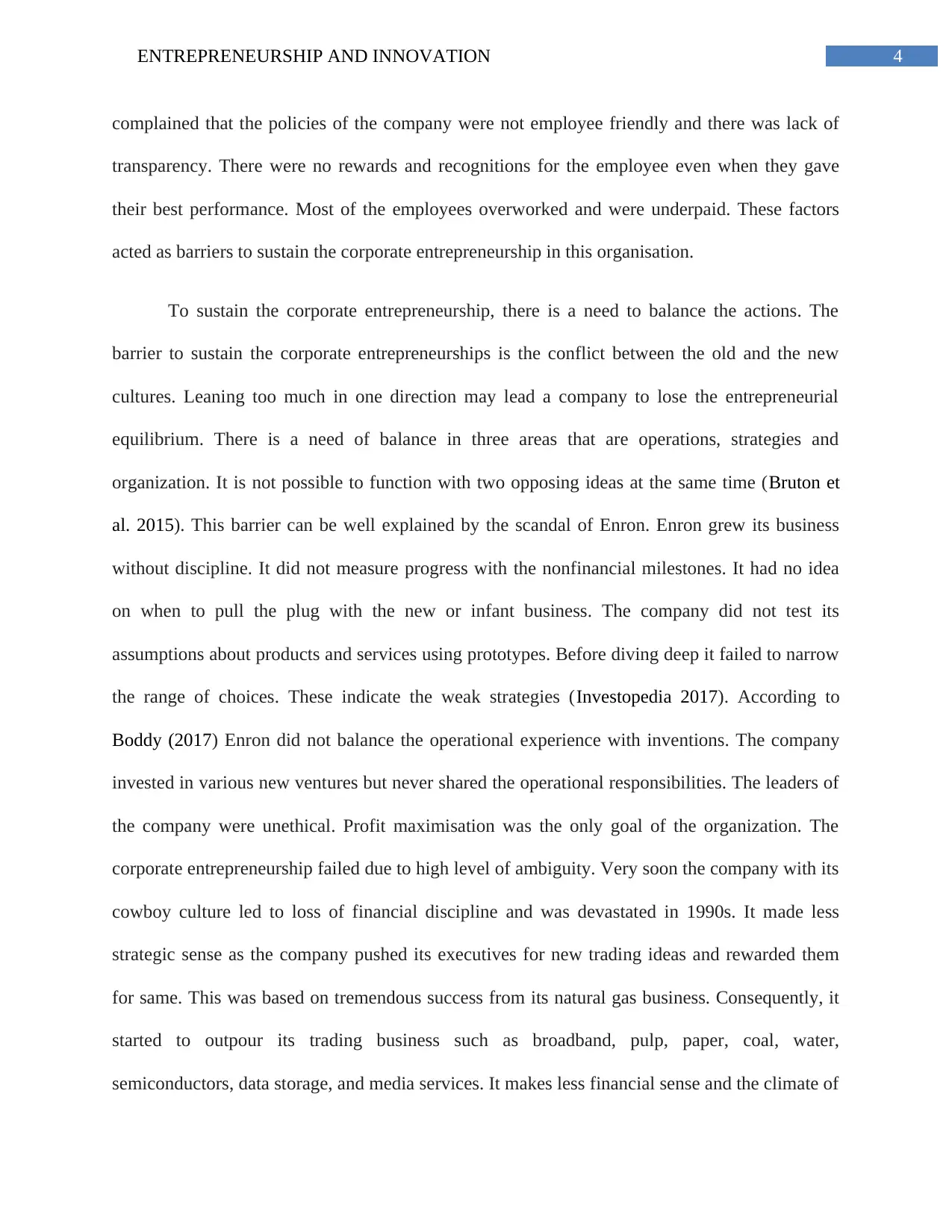
4ENTREPRENEURSHIP AND INNOVATION
complained that the policies of the company were not employee friendly and there was lack of
transparency. There were no rewards and recognitions for the employee even when they gave
their best performance. Most of the employees overworked and were underpaid. These factors
acted as barriers to sustain the corporate entrepreneurship in this organisation.
To sustain the corporate entrepreneurship, there is a need to balance the actions. The
barrier to sustain the corporate entrepreneurships is the conflict between the old and the new
cultures. Leaning too much in one direction may lead a company to lose the entrepreneurial
equilibrium. There is a need of balance in three areas that are operations, strategies and
organization. It is not possible to function with two opposing ideas at the same time (Bruton et
al. 2015). This barrier can be well explained by the scandal of Enron. Enron grew its business
without discipline. It did not measure progress with the nonfinancial milestones. It had no idea
on when to pull the plug with the new or infant business. The company did not test its
assumptions about products and services using prototypes. Before diving deep it failed to narrow
the range of choices. These indicate the weak strategies (Investopedia 2017). According to
Boddy (2017) Enron did not balance the operational experience with inventions. The company
invested in various new ventures but never shared the operational responsibilities. The leaders of
the company were unethical. Profit maximisation was the only goal of the organization. The
corporate entrepreneurship failed due to high level of ambiguity. Very soon the company with its
cowboy culture led to loss of financial discipline and was devastated in 1990s. It made less
strategic sense as the company pushed its executives for new trading ideas and rewarded them
for same. This was based on tremendous success from its natural gas business. Consequently, it
started to outpour its trading business such as broadband, pulp, paper, coal, water,
semiconductors, data storage, and media services. It makes less financial sense and the climate of
complained that the policies of the company were not employee friendly and there was lack of
transparency. There were no rewards and recognitions for the employee even when they gave
their best performance. Most of the employees overworked and were underpaid. These factors
acted as barriers to sustain the corporate entrepreneurship in this organisation.
To sustain the corporate entrepreneurship, there is a need to balance the actions. The
barrier to sustain the corporate entrepreneurships is the conflict between the old and the new
cultures. Leaning too much in one direction may lead a company to lose the entrepreneurial
equilibrium. There is a need of balance in three areas that are operations, strategies and
organization. It is not possible to function with two opposing ideas at the same time (Bruton et
al. 2015). This barrier can be well explained by the scandal of Enron. Enron grew its business
without discipline. It did not measure progress with the nonfinancial milestones. It had no idea
on when to pull the plug with the new or infant business. The company did not test its
assumptions about products and services using prototypes. Before diving deep it failed to narrow
the range of choices. These indicate the weak strategies (Investopedia 2017). According to
Boddy (2017) Enron did not balance the operational experience with inventions. The company
invested in various new ventures but never shared the operational responsibilities. The leaders of
the company were unethical. Profit maximisation was the only goal of the organization. The
corporate entrepreneurship failed due to high level of ambiguity. Very soon the company with its
cowboy culture led to loss of financial discipline and was devastated in 1990s. It made less
strategic sense as the company pushed its executives for new trading ideas and rewarded them
for same. This was based on tremendous success from its natural gas business. Consequently, it
started to outpour its trading business such as broadband, pulp, paper, coal, water,
semiconductors, data storage, and media services. It makes less financial sense and the climate of
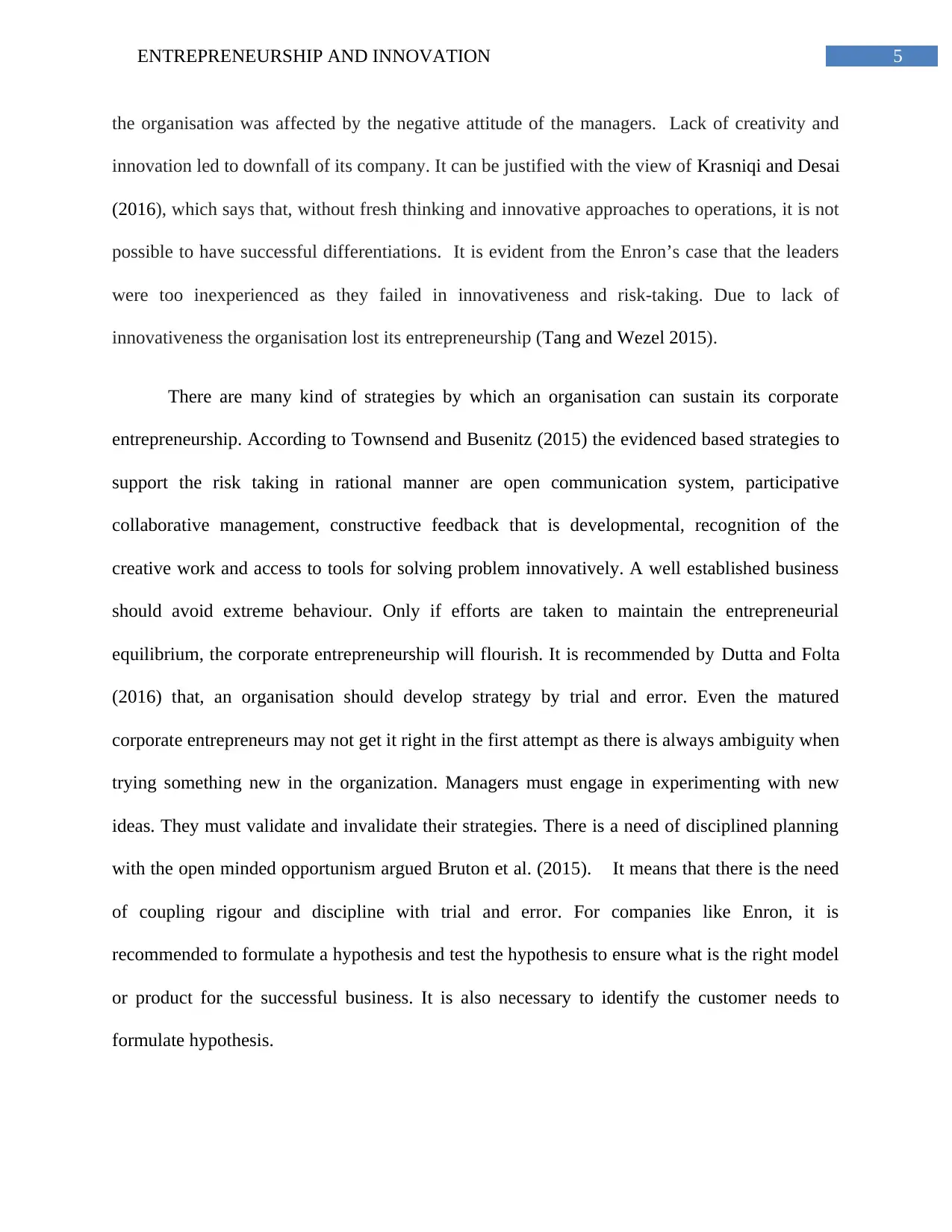
5ENTREPRENEURSHIP AND INNOVATION
the organisation was affected by the negative attitude of the managers. Lack of creativity and
innovation led to downfall of its company. It can be justified with the view of Krasniqi and Desai
(2016), which says that, without fresh thinking and innovative approaches to operations, it is not
possible to have successful differentiations. It is evident from the Enron’s case that the leaders
were too inexperienced as they failed in innovativeness and risk-taking. Due to lack of
innovativeness the organisation lost its entrepreneurship (Tang and Wezel 2015).
There are many kind of strategies by which an organisation can sustain its corporate
entrepreneurship. According to Townsend and Busenitz (2015) the evidenced based strategies to
support the risk taking in rational manner are open communication system, participative
collaborative management, constructive feedback that is developmental, recognition of the
creative work and access to tools for solving problem innovatively. A well established business
should avoid extreme behaviour. Only if efforts are taken to maintain the entrepreneurial
equilibrium, the corporate entrepreneurship will flourish. It is recommended by Dutta and Folta
(2016) that, an organisation should develop strategy by trial and error. Even the matured
corporate entrepreneurs may not get it right in the first attempt as there is always ambiguity when
trying something new in the organization. Managers must engage in experimenting with new
ideas. They must validate and invalidate their strategies. There is a need of disciplined planning
with the open minded opportunism argued Bruton et al. (2015). It means that there is the need
of coupling rigour and discipline with trial and error. For companies like Enron, it is
recommended to formulate a hypothesis and test the hypothesis to ensure what is the right model
or product for the successful business. It is also necessary to identify the customer needs to
formulate hypothesis.
the organisation was affected by the negative attitude of the managers. Lack of creativity and
innovation led to downfall of its company. It can be justified with the view of Krasniqi and Desai
(2016), which says that, without fresh thinking and innovative approaches to operations, it is not
possible to have successful differentiations. It is evident from the Enron’s case that the leaders
were too inexperienced as they failed in innovativeness and risk-taking. Due to lack of
innovativeness the organisation lost its entrepreneurship (Tang and Wezel 2015).
There are many kind of strategies by which an organisation can sustain its corporate
entrepreneurship. According to Townsend and Busenitz (2015) the evidenced based strategies to
support the risk taking in rational manner are open communication system, participative
collaborative management, constructive feedback that is developmental, recognition of the
creative work and access to tools for solving problem innovatively. A well established business
should avoid extreme behaviour. Only if efforts are taken to maintain the entrepreneurial
equilibrium, the corporate entrepreneurship will flourish. It is recommended by Dutta and Folta
(2016) that, an organisation should develop strategy by trial and error. Even the matured
corporate entrepreneurs may not get it right in the first attempt as there is always ambiguity when
trying something new in the organization. Managers must engage in experimenting with new
ideas. They must validate and invalidate their strategies. There is a need of disciplined planning
with the open minded opportunism argued Bruton et al. (2015). It means that there is the need
of coupling rigour and discipline with trial and error. For companies like Enron, it is
recommended to formulate a hypothesis and test the hypothesis to ensure what is the right model
or product for the successful business. It is also necessary to identify the customer needs to
formulate hypothesis.
⊘ This is a preview!⊘
Do you want full access?
Subscribe today to unlock all pages.

Trusted by 1+ million students worldwide
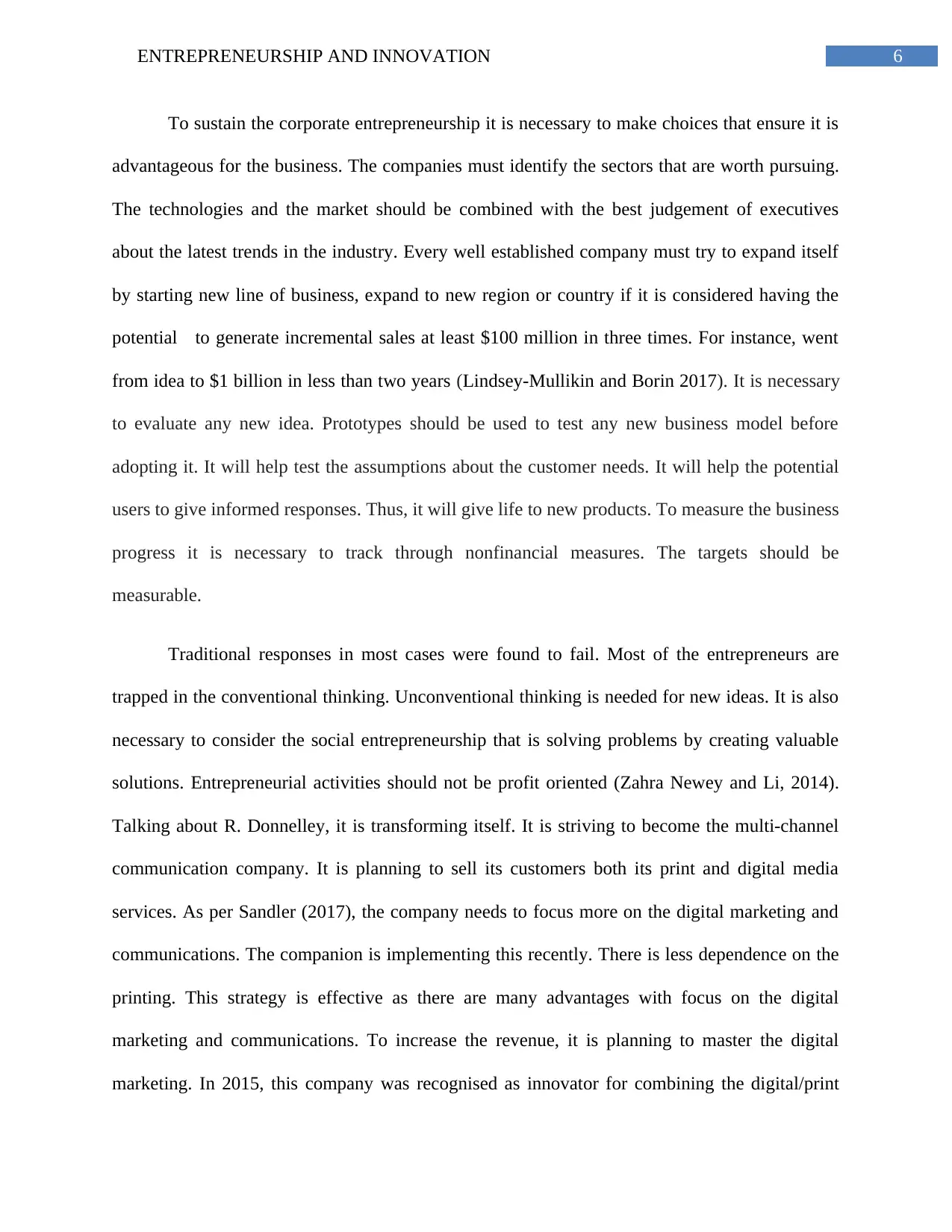
6ENTREPRENEURSHIP AND INNOVATION
To sustain the corporate entrepreneurship it is necessary to make choices that ensure it is
advantageous for the business. The companies must identify the sectors that are worth pursuing.
The technologies and the market should be combined with the best judgement of executives
about the latest trends in the industry. Every well established company must try to expand itself
by starting new line of business, expand to new region or country if it is considered having the
potential to generate incremental sales at least $100 million in three times. For instance, went
from idea to $1 billion in less than two years (Lindsey-Mullikin and Borin 2017). It is necessary
to evaluate any new idea. Prototypes should be used to test any new business model before
adopting it. It will help test the assumptions about the customer needs. It will help the potential
users to give informed responses. Thus, it will give life to new products. To measure the business
progress it is necessary to track through nonfinancial measures. The targets should be
measurable.
Traditional responses in most cases were found to fail. Most of the entrepreneurs are
trapped in the conventional thinking. Unconventional thinking is needed for new ideas. It is also
necessary to consider the social entrepreneurship that is solving problems by creating valuable
solutions. Entrepreneurial activities should not be profit oriented (Zahra Newey and Li, 2014).
Talking about R. Donnelley, it is transforming itself. It is striving to become the multi-channel
communication company. It is planning to sell its customers both its print and digital media
services. As per Sandler (2017), the company needs to focus more on the digital marketing and
communications. The companion is implementing this recently. There is less dependence on the
printing. This strategy is effective as there are many advantages with focus on the digital
marketing and communications. To increase the revenue, it is planning to master the digital
marketing. In 2015, this company was recognised as innovator for combining the digital/print
To sustain the corporate entrepreneurship it is necessary to make choices that ensure it is
advantageous for the business. The companies must identify the sectors that are worth pursuing.
The technologies and the market should be combined with the best judgement of executives
about the latest trends in the industry. Every well established company must try to expand itself
by starting new line of business, expand to new region or country if it is considered having the
potential to generate incremental sales at least $100 million in three times. For instance, went
from idea to $1 billion in less than two years (Lindsey-Mullikin and Borin 2017). It is necessary
to evaluate any new idea. Prototypes should be used to test any new business model before
adopting it. It will help test the assumptions about the customer needs. It will help the potential
users to give informed responses. Thus, it will give life to new products. To measure the business
progress it is necessary to track through nonfinancial measures. The targets should be
measurable.
Traditional responses in most cases were found to fail. Most of the entrepreneurs are
trapped in the conventional thinking. Unconventional thinking is needed for new ideas. It is also
necessary to consider the social entrepreneurship that is solving problems by creating valuable
solutions. Entrepreneurial activities should not be profit oriented (Zahra Newey and Li, 2014).
Talking about R. Donnelley, it is transforming itself. It is striving to become the multi-channel
communication company. It is planning to sell its customers both its print and digital media
services. As per Sandler (2017), the company needs to focus more on the digital marketing and
communications. The companion is implementing this recently. There is less dependence on the
printing. This strategy is effective as there are many advantages with focus on the digital
marketing and communications. To increase the revenue, it is planning to master the digital
marketing. In 2015, this company was recognised as innovator for combining the digital/print
Paraphrase This Document
Need a fresh take? Get an instant paraphrase of this document with our AI Paraphraser
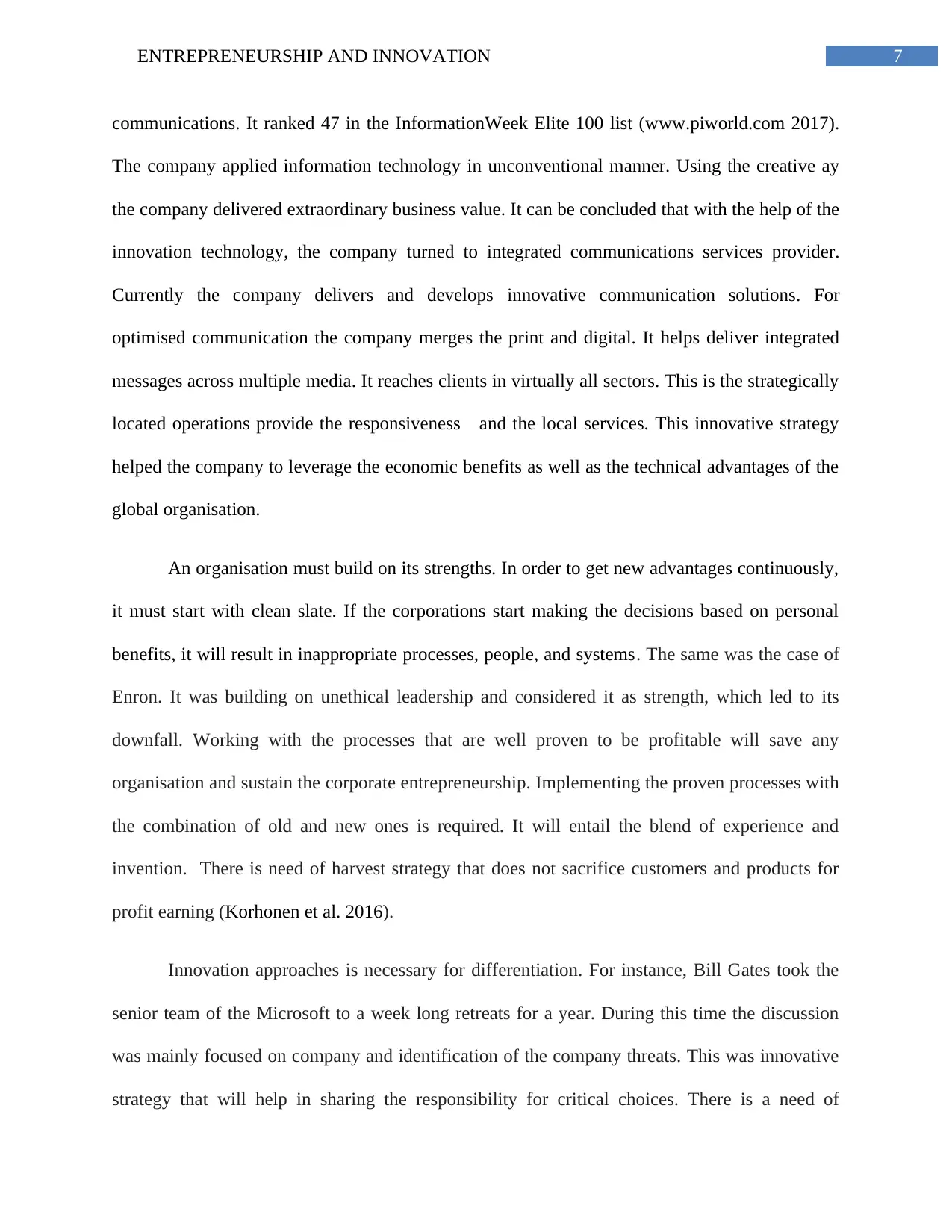
7ENTREPRENEURSHIP AND INNOVATION
communications. It ranked 47 in the InformationWeek Elite 100 list (www.piworld.com 2017).
The company applied information technology in unconventional manner. Using the creative ay
the company delivered extraordinary business value. It can be concluded that with the help of the
innovation technology, the company turned to integrated communications services provider.
Currently the company delivers and develops innovative communication solutions. For
optimised communication the company merges the print and digital. It helps deliver integrated
messages across multiple media. It reaches clients in virtually all sectors. This is the strategically
located operations provide the responsiveness and the local services. This innovative strategy
helped the company to leverage the economic benefits as well as the technical advantages of the
global organisation.
An organisation must build on its strengths. In order to get new advantages continuously,
it must start with clean slate. If the corporations start making the decisions based on personal
benefits, it will result in inappropriate processes, people, and systems. The same was the case of
Enron. It was building on unethical leadership and considered it as strength, which led to its
downfall. Working with the processes that are well proven to be profitable will save any
organisation and sustain the corporate entrepreneurship. Implementing the proven processes with
the combination of old and new ones is required. It will entail the blend of experience and
invention. There is need of harvest strategy that does not sacrifice customers and products for
profit earning (Korhonen et al. 2016).
Innovation approaches is necessary for differentiation. For instance, Bill Gates took the
senior team of the Microsoft to a week long retreats for a year. During this time the discussion
was mainly focused on company and identification of the company threats. This was innovative
strategy that will help in sharing the responsibility for critical choices. There is a need of
communications. It ranked 47 in the InformationWeek Elite 100 list (www.piworld.com 2017).
The company applied information technology in unconventional manner. Using the creative ay
the company delivered extraordinary business value. It can be concluded that with the help of the
innovation technology, the company turned to integrated communications services provider.
Currently the company delivers and develops innovative communication solutions. For
optimised communication the company merges the print and digital. It helps deliver integrated
messages across multiple media. It reaches clients in virtually all sectors. This is the strategically
located operations provide the responsiveness and the local services. This innovative strategy
helped the company to leverage the economic benefits as well as the technical advantages of the
global organisation.
An organisation must build on its strengths. In order to get new advantages continuously,
it must start with clean slate. If the corporations start making the decisions based on personal
benefits, it will result in inappropriate processes, people, and systems. The same was the case of
Enron. It was building on unethical leadership and considered it as strength, which led to its
downfall. Working with the processes that are well proven to be profitable will save any
organisation and sustain the corporate entrepreneurship. Implementing the proven processes with
the combination of old and new ones is required. It will entail the blend of experience and
invention. There is need of harvest strategy that does not sacrifice customers and products for
profit earning (Korhonen et al. 2016).
Innovation approaches is necessary for differentiation. For instance, Bill Gates took the
senior team of the Microsoft to a week long retreats for a year. During this time the discussion
was mainly focused on company and identification of the company threats. This was innovative
strategy that will help in sharing the responsibility for critical choices. There is a need of
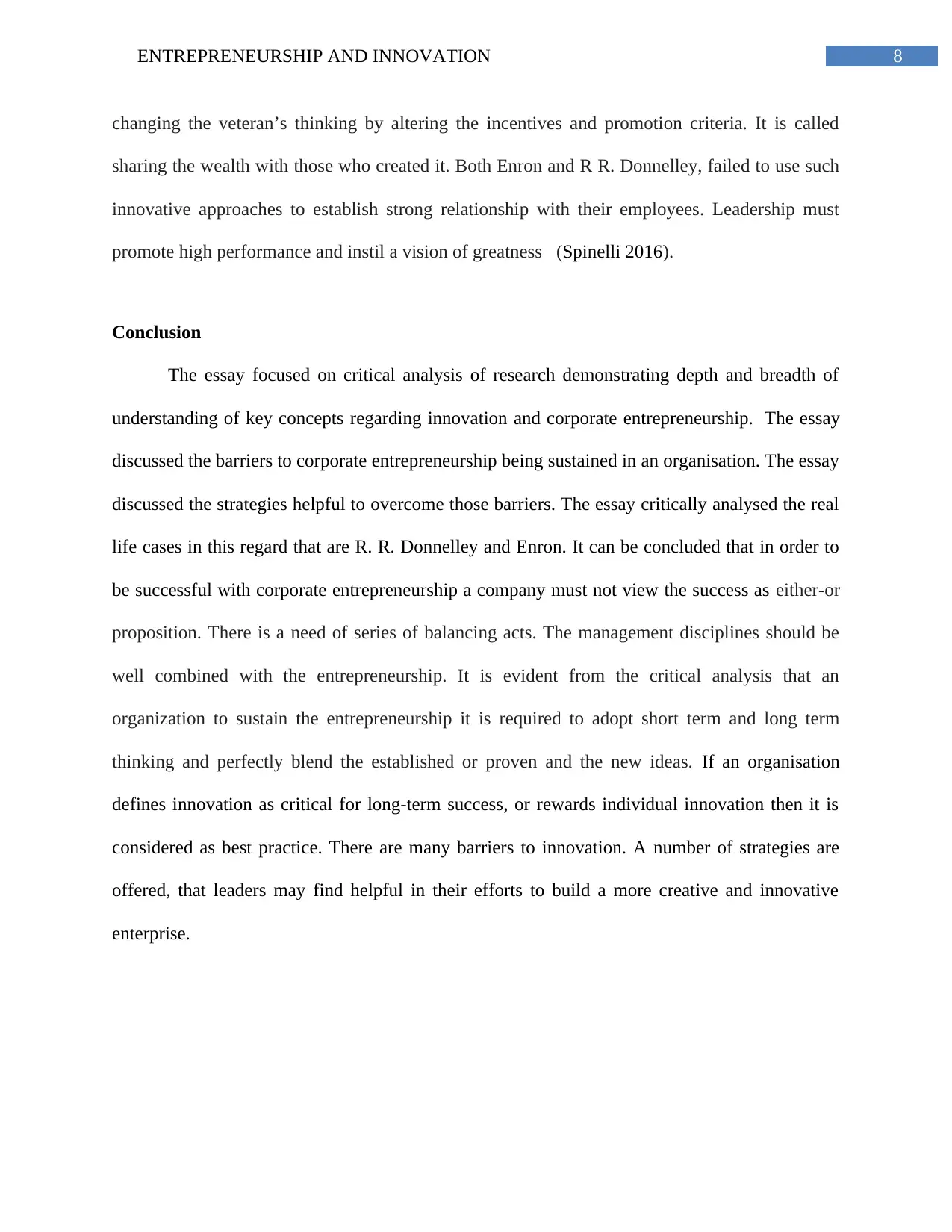
8ENTREPRENEURSHIP AND INNOVATION
changing the veteran’s thinking by altering the incentives and promotion criteria. It is called
sharing the wealth with those who created it. Both Enron and R R. Donnelley, failed to use such
innovative approaches to establish strong relationship with their employees. Leadership must
promote high performance and instil a vision of greatness (Spinelli 2016).
Conclusion
The essay focused on critical analysis of research demonstrating depth and breadth of
understanding of key concepts regarding innovation and corporate entrepreneurship. The essay
discussed the barriers to corporate entrepreneurship being sustained in an organisation. The essay
discussed the strategies helpful to overcome those barriers. The essay critically analysed the real
life cases in this regard that are R. R. Donnelley and Enron. It can be concluded that in order to
be successful with corporate entrepreneurship a company must not view the success as either-or
proposition. There is a need of series of balancing acts. The management disciplines should be
well combined with the entrepreneurship. It is evident from the critical analysis that an
organization to sustain the entrepreneurship it is required to adopt short term and long term
thinking and perfectly blend the established or proven and the new ideas. If an organisation
defines innovation as critical for long-term success, or rewards individual innovation then it is
considered as best practice. There are many barriers to innovation. A number of strategies are
offered, that leaders may find helpful in their efforts to build a more creative and innovative
enterprise.
changing the veteran’s thinking by altering the incentives and promotion criteria. It is called
sharing the wealth with those who created it. Both Enron and R R. Donnelley, failed to use such
innovative approaches to establish strong relationship with their employees. Leadership must
promote high performance and instil a vision of greatness (Spinelli 2016).
Conclusion
The essay focused on critical analysis of research demonstrating depth and breadth of
understanding of key concepts regarding innovation and corporate entrepreneurship. The essay
discussed the barriers to corporate entrepreneurship being sustained in an organisation. The essay
discussed the strategies helpful to overcome those barriers. The essay critically analysed the real
life cases in this regard that are R. R. Donnelley and Enron. It can be concluded that in order to
be successful with corporate entrepreneurship a company must not view the success as either-or
proposition. There is a need of series of balancing acts. The management disciplines should be
well combined with the entrepreneurship. It is evident from the critical analysis that an
organization to sustain the entrepreneurship it is required to adopt short term and long term
thinking and perfectly blend the established or proven and the new ideas. If an organisation
defines innovation as critical for long-term success, or rewards individual innovation then it is
considered as best practice. There are many barriers to innovation. A number of strategies are
offered, that leaders may find helpful in their efforts to build a more creative and innovative
enterprise.
⊘ This is a preview!⊘
Do you want full access?
Subscribe today to unlock all pages.

Trusted by 1+ million students worldwide
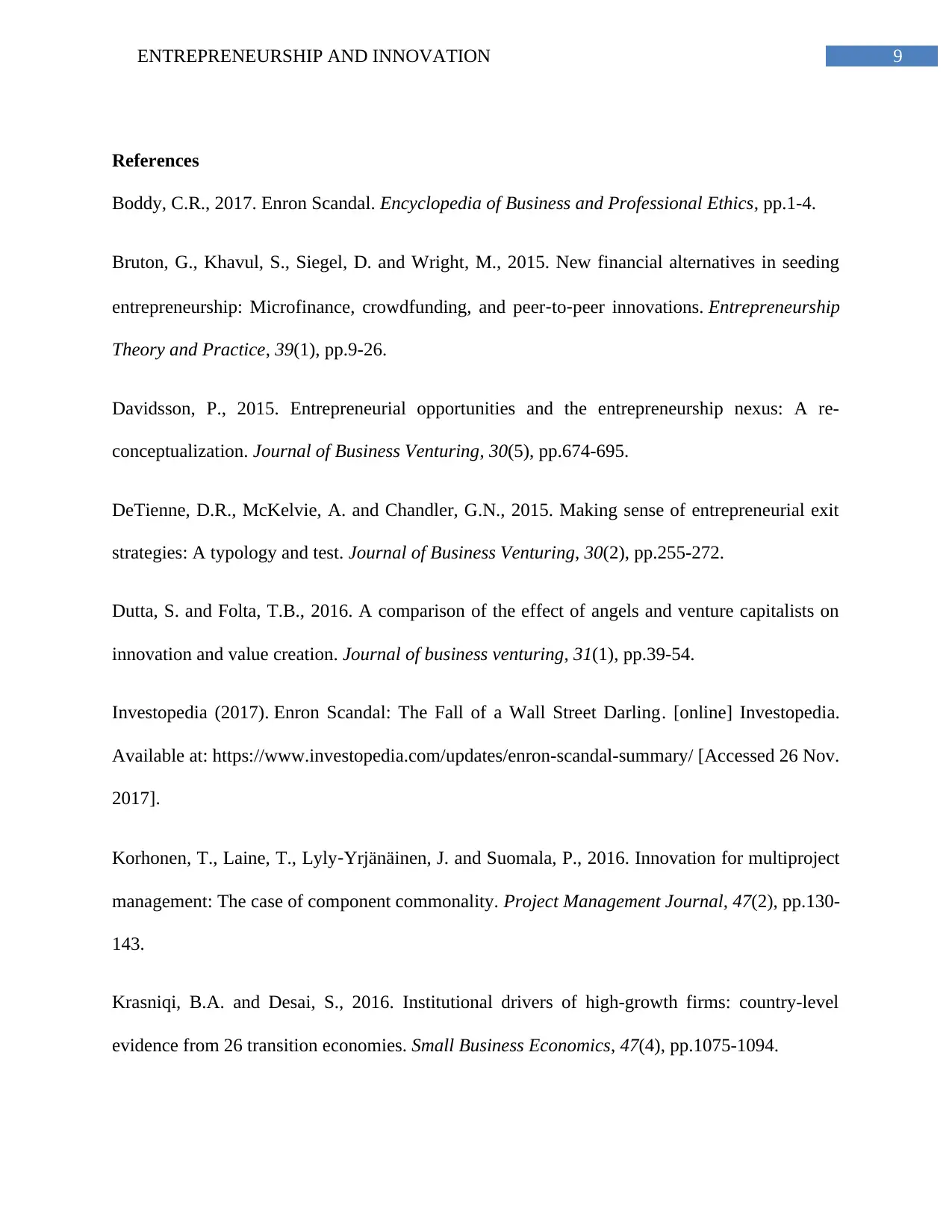
9ENTREPRENEURSHIP AND INNOVATION
References
Boddy, C.R., 2017. Enron Scandal. Encyclopedia of Business and Professional Ethics, pp.1-4.
Bruton, G., Khavul, S., Siegel, D. and Wright, M., 2015. New financial alternatives in seeding
entrepreneurship: Microfinance, crowdfunding, and peer‐to‐peer innovations. Entrepreneurship
Theory and Practice, 39(1), pp.9-26.
Davidsson, P., 2015. Entrepreneurial opportunities and the entrepreneurship nexus: A re-
conceptualization. Journal of Business Venturing, 30(5), pp.674-695.
DeTienne, D.R., McKelvie, A. and Chandler, G.N., 2015. Making sense of entrepreneurial exit
strategies: A typology and test. Journal of Business Venturing, 30(2), pp.255-272.
Dutta, S. and Folta, T.B., 2016. A comparison of the effect of angels and venture capitalists on
innovation and value creation. Journal of business venturing, 31(1), pp.39-54.
Investopedia (2017). Enron Scandal: The Fall of a Wall Street Darling. [online] Investopedia.
Available at: https://www.investopedia.com/updates/enron-scandal-summary/ [Accessed 26 Nov.
2017].
Korhonen, T., Laine, T., Lyly‐Yrjänäinen, J. and Suomala, P., 2016. Innovation for multiproject
management: The case of component commonality. Project Management Journal, 47(2), pp.130-
143.
Krasniqi, B.A. and Desai, S., 2016. Institutional drivers of high-growth firms: country-level
evidence from 26 transition economies. Small Business Economics, 47(4), pp.1075-1094.
References
Boddy, C.R., 2017. Enron Scandal. Encyclopedia of Business and Professional Ethics, pp.1-4.
Bruton, G., Khavul, S., Siegel, D. and Wright, M., 2015. New financial alternatives in seeding
entrepreneurship: Microfinance, crowdfunding, and peer‐to‐peer innovations. Entrepreneurship
Theory and Practice, 39(1), pp.9-26.
Davidsson, P., 2015. Entrepreneurial opportunities and the entrepreneurship nexus: A re-
conceptualization. Journal of Business Venturing, 30(5), pp.674-695.
DeTienne, D.R., McKelvie, A. and Chandler, G.N., 2015. Making sense of entrepreneurial exit
strategies: A typology and test. Journal of Business Venturing, 30(2), pp.255-272.
Dutta, S. and Folta, T.B., 2016. A comparison of the effect of angels and venture capitalists on
innovation and value creation. Journal of business venturing, 31(1), pp.39-54.
Investopedia (2017). Enron Scandal: The Fall of a Wall Street Darling. [online] Investopedia.
Available at: https://www.investopedia.com/updates/enron-scandal-summary/ [Accessed 26 Nov.
2017].
Korhonen, T., Laine, T., Lyly‐Yrjänäinen, J. and Suomala, P., 2016. Innovation for multiproject
management: The case of component commonality. Project Management Journal, 47(2), pp.130-
143.
Krasniqi, B.A. and Desai, S., 2016. Institutional drivers of high-growth firms: country-level
evidence from 26 transition economies. Small Business Economics, 47(4), pp.1075-1094.
Paraphrase This Document
Need a fresh take? Get an instant paraphrase of this document with our AI Paraphraser
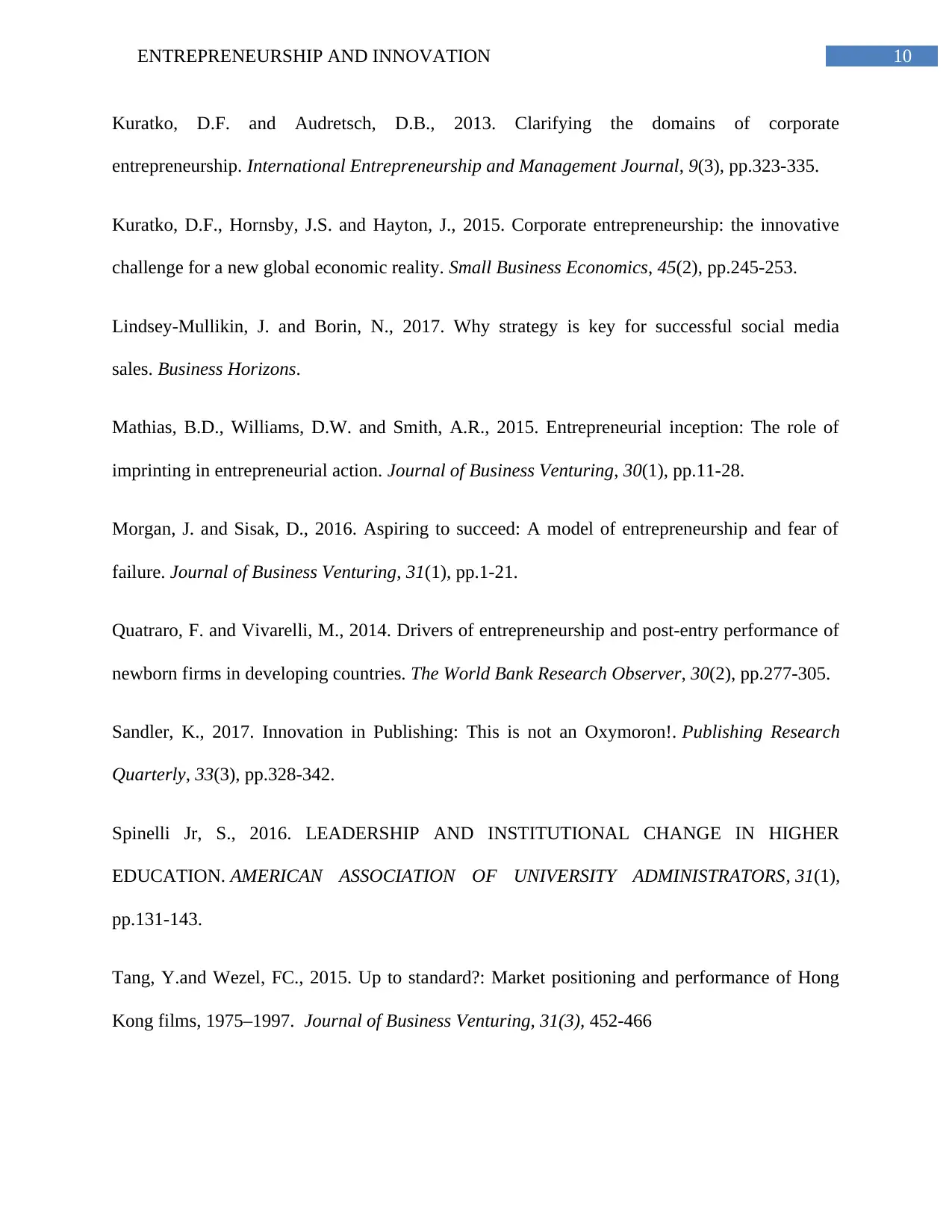
10ENTREPRENEURSHIP AND INNOVATION
Kuratko, D.F. and Audretsch, D.B., 2013. Clarifying the domains of corporate
entrepreneurship. International Entrepreneurship and Management Journal, 9(3), pp.323-335.
Kuratko, D.F., Hornsby, J.S. and Hayton, J., 2015. Corporate entrepreneurship: the innovative
challenge for a new global economic reality. Small Business Economics, 45(2), pp.245-253.
Lindsey-Mullikin, J. and Borin, N., 2017. Why strategy is key for successful social media
sales. Business Horizons.
Mathias, B.D., Williams, D.W. and Smith, A.R., 2015. Entrepreneurial inception: The role of
imprinting in entrepreneurial action. Journal of Business Venturing, 30(1), pp.11-28.
Morgan, J. and Sisak, D., 2016. Aspiring to succeed: A model of entrepreneurship and fear of
failure. Journal of Business Venturing, 31(1), pp.1-21.
Quatraro, F. and Vivarelli, M., 2014. Drivers of entrepreneurship and post-entry performance of
newborn firms in developing countries. The World Bank Research Observer, 30(2), pp.277-305.
Sandler, K., 2017. Innovation in Publishing: This is not an Oxymoron!. Publishing Research
Quarterly, 33(3), pp.328-342.
Spinelli Jr, S., 2016. LEADERSHIP AND INSTITUTIONAL CHANGE IN HIGHER
EDUCATION. AMERICAN ASSOCIATION OF UNIVERSITY ADMINISTRATORS, 31(1),
pp.131-143.
Tang, Y.and Wezel, FC., 2015. Up to standard?: Market positioning and performance of Hong
Kong films, 1975–1997. Journal of Business Venturing, 31(3), 452-466
Kuratko, D.F. and Audretsch, D.B., 2013. Clarifying the domains of corporate
entrepreneurship. International Entrepreneurship and Management Journal, 9(3), pp.323-335.
Kuratko, D.F., Hornsby, J.S. and Hayton, J., 2015. Corporate entrepreneurship: the innovative
challenge for a new global economic reality. Small Business Economics, 45(2), pp.245-253.
Lindsey-Mullikin, J. and Borin, N., 2017. Why strategy is key for successful social media
sales. Business Horizons.
Mathias, B.D., Williams, D.W. and Smith, A.R., 2015. Entrepreneurial inception: The role of
imprinting in entrepreneurial action. Journal of Business Venturing, 30(1), pp.11-28.
Morgan, J. and Sisak, D., 2016. Aspiring to succeed: A model of entrepreneurship and fear of
failure. Journal of Business Venturing, 31(1), pp.1-21.
Quatraro, F. and Vivarelli, M., 2014. Drivers of entrepreneurship and post-entry performance of
newborn firms in developing countries. The World Bank Research Observer, 30(2), pp.277-305.
Sandler, K., 2017. Innovation in Publishing: This is not an Oxymoron!. Publishing Research
Quarterly, 33(3), pp.328-342.
Spinelli Jr, S., 2016. LEADERSHIP AND INSTITUTIONAL CHANGE IN HIGHER
EDUCATION. AMERICAN ASSOCIATION OF UNIVERSITY ADMINISTRATORS, 31(1),
pp.131-143.
Tang, Y.and Wezel, FC., 2015. Up to standard?: Market positioning and performance of Hong
Kong films, 1975–1997. Journal of Business Venturing, 31(3), 452-466
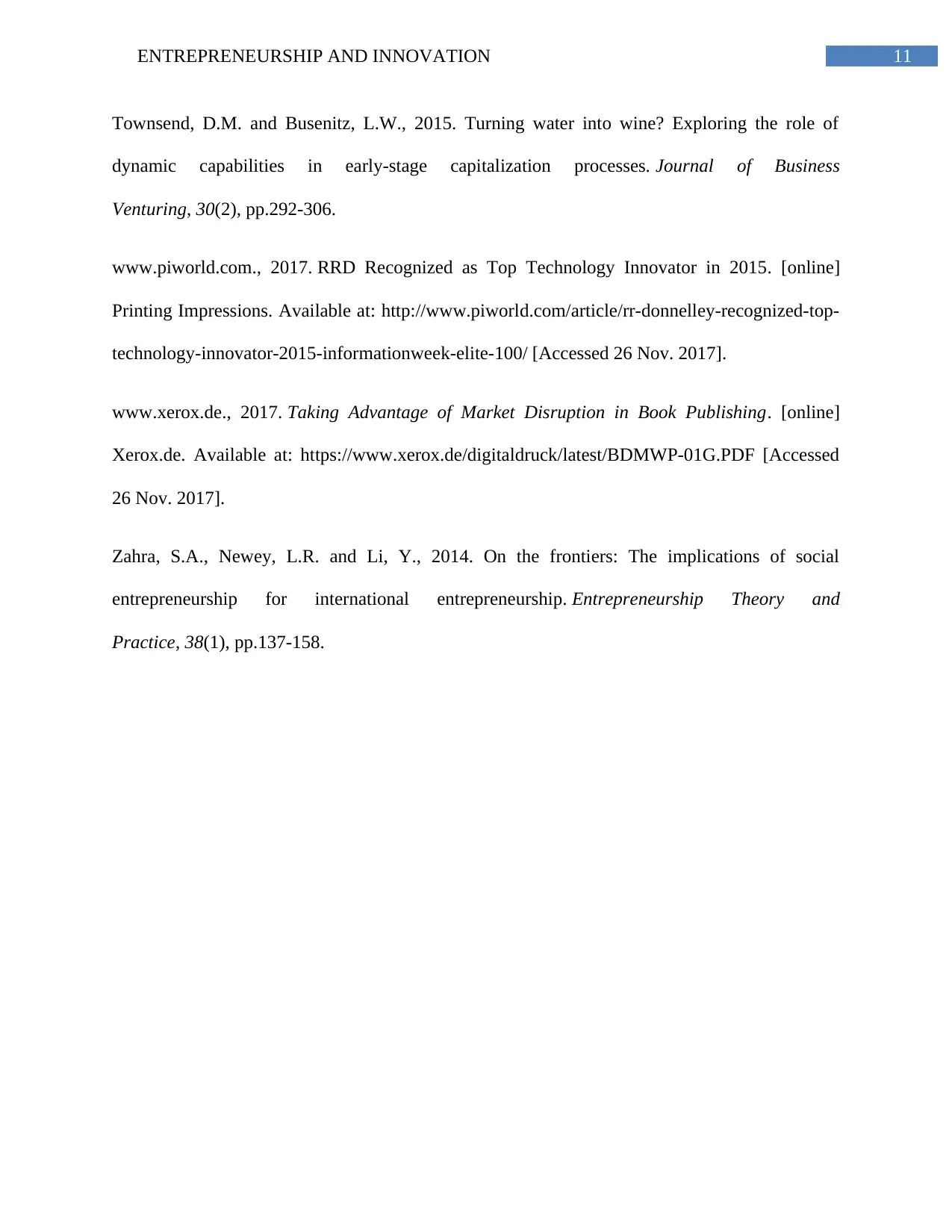
11ENTREPRENEURSHIP AND INNOVATION
Townsend, D.M. and Busenitz, L.W., 2015. Turning water into wine? Exploring the role of
dynamic capabilities in early-stage capitalization processes. Journal of Business
Venturing, 30(2), pp.292-306.
www.piworld.com., 2017. RRD Recognized as Top Technology Innovator in 2015. [online]
Printing Impressions. Available at: http://www.piworld.com/article/rr-donnelley-recognized-top-
technology-innovator-2015-informationweek-elite-100/ [Accessed 26 Nov. 2017].
www.xerox.de., 2017. Taking Advantage of Market Disruption in Book Publishing. [online]
Xerox.de. Available at: https://www.xerox.de/digitaldruck/latest/BDMWP-01G.PDF [Accessed
26 Nov. 2017].
Zahra, S.A., Newey, L.R. and Li, Y., 2014. On the frontiers: The implications of social
entrepreneurship for international entrepreneurship. Entrepreneurship Theory and
Practice, 38(1), pp.137-158.
Townsend, D.M. and Busenitz, L.W., 2015. Turning water into wine? Exploring the role of
dynamic capabilities in early-stage capitalization processes. Journal of Business
Venturing, 30(2), pp.292-306.
www.piworld.com., 2017. RRD Recognized as Top Technology Innovator in 2015. [online]
Printing Impressions. Available at: http://www.piworld.com/article/rr-donnelley-recognized-top-
technology-innovator-2015-informationweek-elite-100/ [Accessed 26 Nov. 2017].
www.xerox.de., 2017. Taking Advantage of Market Disruption in Book Publishing. [online]
Xerox.de. Available at: https://www.xerox.de/digitaldruck/latest/BDMWP-01G.PDF [Accessed
26 Nov. 2017].
Zahra, S.A., Newey, L.R. and Li, Y., 2014. On the frontiers: The implications of social
entrepreneurship for international entrepreneurship. Entrepreneurship Theory and
Practice, 38(1), pp.137-158.
⊘ This is a preview!⊘
Do you want full access?
Subscribe today to unlock all pages.

Trusted by 1+ million students worldwide
1 out of 12
Related Documents
Your All-in-One AI-Powered Toolkit for Academic Success.
+13062052269
info@desklib.com
Available 24*7 on WhatsApp / Email
![[object Object]](/_next/static/media/star-bottom.7253800d.svg)
Unlock your academic potential
Copyright © 2020–2025 A2Z Services. All Rights Reserved. Developed and managed by ZUCOL.





